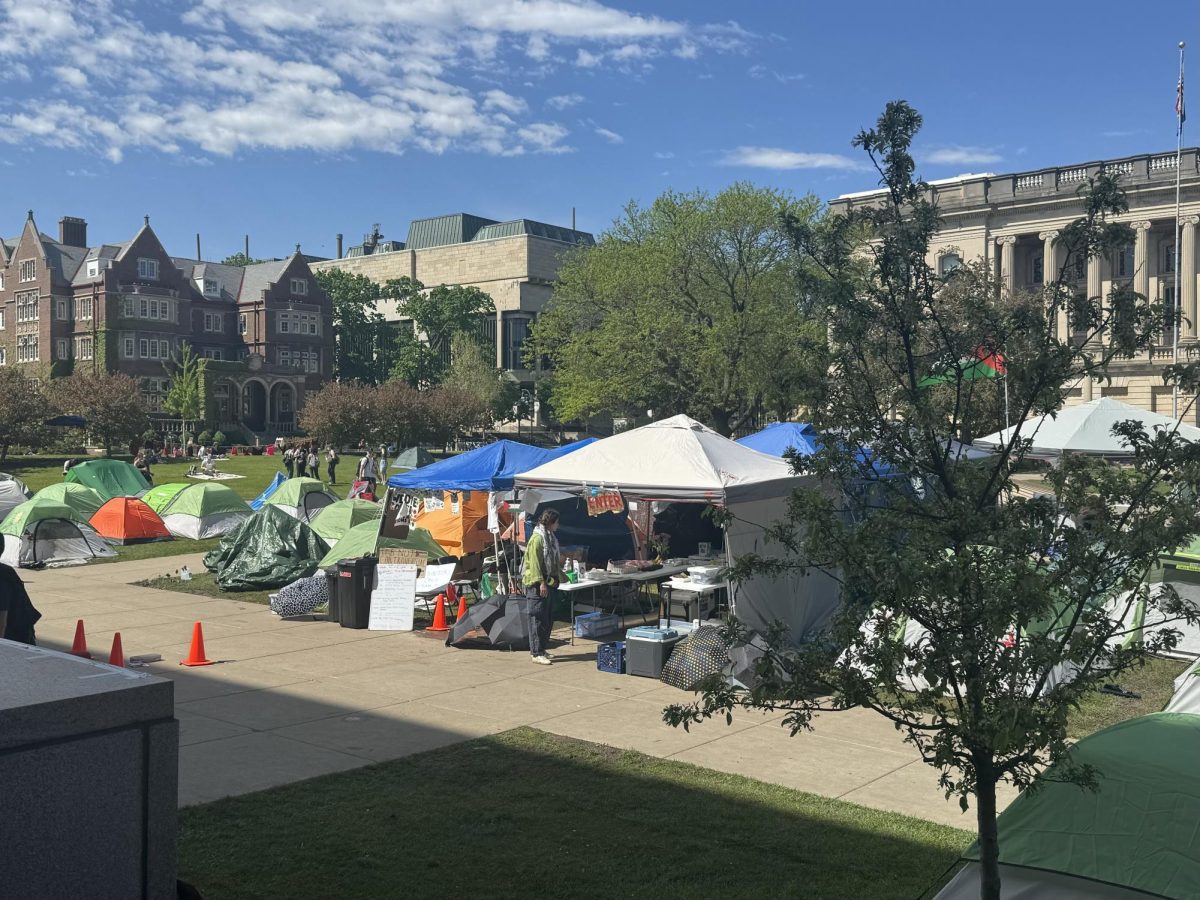If you’ve tuned in to campus news any time over the past 10 years, you’ve probably heard of the General Student Services Fund, our student government’s poorly structured funding opportunity for student organizations. Every year, some service organizations are awarded upwards of $100,000 apiece, while others central to our community are left high and dry – leaving us to both foot the bill and suffer as a result.
I’ve come to believe that complete, public transparency as to how this fund operates will be necessary to countervail the bureaucratic inertia which has hindered past attempts at reform. Today, I want to share my knowledge of this process in the hope that, by realizing the absurd details of what’s occurring, you become as upset as I am that this is allowed to continue.
Next week, a new Associated Students of Madison constitution will come to a campus vote, and with it a rare opportunity to empower our student leaders with the tools they need to make what’s written here obsolete. I implore you to vote yes and, in so doing, bring some sanity to the way our dollars get handed out.
Matthew Manes
How to Gain GSSF Eligibility in 10 Easy Steps
So you’ve decided you want $100,000 for your student organization to provide a service to the campus? Excellent! Just follow these steps and you’ll be on your way to funding.
- Pick a service you want to provide the student body
It doesn’t really matter what this service is because the people evaluating it will be bound by something called “viewpoint neutrality,” which means they cannot take your viewpoint into consideration. Or, put another way, it doesn’t matter how silly, stupid or out there your service is, because they’ll be judging you based on 16 yes or no criteria. If you meet the criteria, which is what this 10 step guideline is all about, then they are legally bound to fund your activities!
How, you might ask? It’s simple.
2. Design your organization to satisfy the GSSF
In order to qualify for GSSF funds, your group must be centered around providing to campus what’s defined as a “direct service.” The idea is that you’d be receiving funding, not for your own benefit, but for the benefit of the student body. The reality is a huge disconnect exists here – you, the applicant, not ASM, determine what you want to provide. I would still hope you, dear reader, use the information contained here with prudence because ultimately your peers will be forced to pay for it.
Anyway, a “direct service” is a program with the following characteristics:
- The program can be available upon request by recipients
You need to be able to provide your service following a request by a student. You’re allowed to set specific dates and times for when you would put on your service, but you need to be prepared to provide your service outside of that as well.
- The program can be tailored subject to the needs of the recipients within the mission of the group
This one can be tricky, but what it boils down to is you can’t have a one size fits all approach. Whether it’s providing subject matter in response to a student’s request or providing instruction that’s skill level and ability appropriate, you need some degree of recipient-specific customizability.
- The program must be accessible to the recipients regardless of recipient’s participation and/or membership in the group
You can’t require recipients to participate as agents on behalf of your organization as part of your service. Make sure to avoid incorporating mission-furthering activities because while members actively further the goals of your organization, recipients do not.
- The program must be available to recipients continually throughout the course of the fiscal year
This means when everyone else goes home for summer and winter breaks, you still need to be able to provide the service. You may have lower volume and shorter hours, but service still needs to be available.
- The program is not an individual event, series of events, publication or a leadership development opportunity for group members.
The word “event” means a program occurring exclusively on a specific date set by your organization. An exemption exists such that if the program is also requestable, tailorable and educational, it can still qualify. However, publications and group development for your members still don’t.
- The direct service must be educational but cannot be credit producing
This should be self-explanatory.
So, what kind of archetypal, plug-and-play program can you offer that has these characteristics? Why, workshops of course! Pick your activity, build a workshop to teach others how to do your activity, then make it requestable, tailorable, available year-round and boom! You have a direct service and have satisfied the first requirement for funding.
It isn’t enough though that you provide a direct service to warrant your $100,000 request, you need to satisfy several other requirements as well. They’re broken down as follows:
University student requirements
Four requirements deal with the issue of university students versus non-students. More than 75 percent of the time your organization spends planning, coordinating and implementing your direct service has to be spent on university students. The same goes for your programming in general.
Additionally, greater than 75 percent of the people who receive your programming, be it direct services or other, must be university students. The easiest way to make sure you satisfy these requirements is to require a student ID to do anything with your organization, thus sidestepping the issue entirely.
Your direct service must also be aimed at reaching all university students – essentially, to make an effort to reach out to the entire campus and aim to make it as universally accessible as possible. You don’t need to actually serve all students, nor do you need to have something with broad appeal, but you must aim at reaching everyone.
Direct service requirements
Because student organizations often do other activities in addition to direct services, there are requirements about how much direct service you do to qualify for funding.
First, you must provide a written mission statement for your direct service. Next, of all the time your organization spends planning, coordinating and implementing everything, more than 50 percent of that must be spent on your direct service.
Finally, you must demonstrate the university does not provide a substantially equivalent direct service. Other student organizations don’t count, and neither do university services that aren’t direct services.
Other Requirements
If you have not received GSSF funding before, you’ll need to submit a written plan on how you will administer your budget, a paragraph or two. Your group cannot have violated any laws or ASM/University policies in the past 2 years, and you must complete the application and show up to your hearing (duh).
Finally, your group must also be a Registered Student Organization and have written governing documents.
3. Write governing documents
http://cfli.wisc.edu/guide/constitutions_bylaws.htm
Keeping in mind the requirements you’ll ultimately need to fulfill, you need to begin building the structure to your organization by writing a constitution or bylaws. How you structure your organization is completely up to you, and the Center for Leadership and Involvement does a great job of explaining how to write a constitution, providing examples in the link above. As a pro-tip, you might want to empower the leadership of your organization to make most of the decisions for the organization and charge them with maintaining compliancy with the requirements. A catch-all clause to that effect would go a long way, and would read something like:
“The [leadership] of [your organization] shall have the charge and authority to intervene and maintain compliancy with all GSSF criteria in the event [your organization] is deemed eligible for GSSF funds. In so doing, the following parameters will be actively monitored and managed:
-Staff and member time spent on activities not directly pursuant to the direct service(s)
-Total, unique and non-student recipients for the direct service(s) and all other programming
-Student/non-student group composition”
With this clause, even if a disqualifying mistake is made elsewhere in your application or in satisfying the requirements, you’ve essentially underwrote everything and guaranteed you’ll meet the GSSF requirements anyway. It’s akin to a real-life “Arabian Nights,” and you’re Ali Baba: if you can handle the guards, the only thing between you and your goal is uttering a few magic words.
4. Register with the Center for Leadership and Involvement
http://www.cfli.wisc.edu/guide/HowToRegister.htm
As of writing this, there were 880 registered student organizations at the University of Wisconsin. Registering is a piece of cake – all it really takes is four students and a little bit of paperwork. CfLI typically begins accepting registrations at the beginning of August for the upcoming school year. You’ll want to submit everything as soon as they let you, because processing that many registrations can take a month or two and you’ll have deadlines fast approaching.
5. Write an eligibility application
http://www.asm.wisc.edu/ssfc-forms.html
At this point, your timeline becomes important. Although the date changes annually, the deadlines for your applications at points overlap during August and September. From this arises the very real possibility that your RSO registration will not have gone through by the time you need to submit your GSSF applications, but that’s OK. As long as you’ve submitted your documents and are waiting for CfLI to process your registration, just mention it on your application and by the time your hearings roll around a month or two later you should have that cleared and will meet the RSO requirement.
When writing your eligibility application, your job is to demonstrate you meet all of the requirements. Flesh out your service and how you intend to put it on, in as much technical detail as possible. Remember, they can’t evaluate your application based on subjective notions such as “good” or bad,” so don’t bother trying to convince them along those lines.
The entire process is described in detail beginning on page 24 of the official GSSF Financial Guide (linked above), and an example application can be found on page 149.
6. Determine costs and write a budget application
This is where you connect your idea for a service to the funding to make it happen. Figure out everything you would need to do it right: staff, equipment, advertising, travel, etc. The ASM financial staff and the Student Services Finance Committee leadership are available to help you determine what appropriate amounts would be and review your request for errors. Make sure to link your request to the service you want approved, and of course stress how central the funding is to your ability to perform your service.
7. Submit your applications
Check the ASM website for deadlines, and do this on time.
8. Present your eligibility, and say how your service meets their definitions
Once you’ve submitted an application, you’ll be given a hearing in which you have 15 minutes to present the application and 30 minutes to answer questions. Give an overview of your organization, describe your services and then walk down the list of criteria, one-by-one. In no uncertain terms, discuss each requirement and how you satisfy it, as if they’ll be checking these requirements off a list as you go, because they will be (see page 30 of the Financial Guide). Be concise, and if you’re asked a difficult question that you aren’t prepared to answer, write it down and get back to them later – if you try to make something up on the spot, you might get into trouble.
If you’ve done everything right, the committee will vote “aye” on your application, and you’ll move on to the next step.
9. Present your budget, and say why you need money to do your service
Same deal as before, 15 minutes to present followed by 30 minutes to answer questions. Remind the committee about your service and how you provide it, and then proceed to walk down your budget line by line. Be prepared to defend everything in it as necessary, explaining that without this funding, your service to the student body will suffer. Then sit back and wait for them to approve your funding award.
10. Go out and provide your service
Congratulations! You deserve this money…sort of.
Matthew Manes ([email protected]) is a former Chair of the Student Services Finance Committee.




















